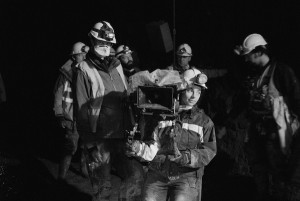Beaconsfield Telemovie: Coming up for air
For 15 days in 2006, the world watched the Beaconsfield mine disaster unfold in the media. This time, the team behind Beaconsfield: The Telemovie go 925 metres below the surface to truly reveal the claustrophobic terror. Colin Delaney goes on location, to the coalface.
 Entering the site, it’s pitch black and damp. Small white spotlights illuminate the darkness but only so far. Moving closer to the source it’s clear – the lights are headlamps on the workers, also dressed in day-glo vests. It’s ‘safety first’ down here and just as a mine should feel, but Encore is on a film set.
Entering the site, it’s pitch black and damp. Small white spotlights illuminate the darkness but only so far. Moving closer to the source it’s clear – the lights are headlamps on the workers, also dressed in day-glo vests. It’s ‘safety first’ down here and just as a mine should feel, but Encore is on a film set.
This is the Beaconsfield mineshaft – ‘the 925’ (925 metres below ground) where Todd Russell, Brant Webb and Larry Knight became trapped on ANZAC Day 2006.
Lachy Hulme (Offspring) plays Todd Russell. “My first question to Glendyn Ivin (director – Offspring, Last Ride) was why are we telling this story, because it’s otherwise just ‘the boy stuck down the well’? [But] the way that the script has been put together, and Glendyn understands narrative so well, it’s a fucking horror story. It gets so dark and scary.”


Great location yarn Colin, just watch out for the “coalface” reference with breakout intro, as Beaconsfield was a gold mine. Interesting to read John Edward’s interest in the story, given that he’s had a long-standing interest in the story of mining in this country. in the early 80s when he was at the now defunct Film Australia, he wrote a 1st ep draft teleplay about one of the giants of the coalmining industry – long remembered as King Coal in this Northern coalfields of the Hunter Valley. Should ask him about it.
Point taken Greg, admittedly I took a little poetic licence. No offence to either mining crews out there, from the guy with ‘typing blisters’.